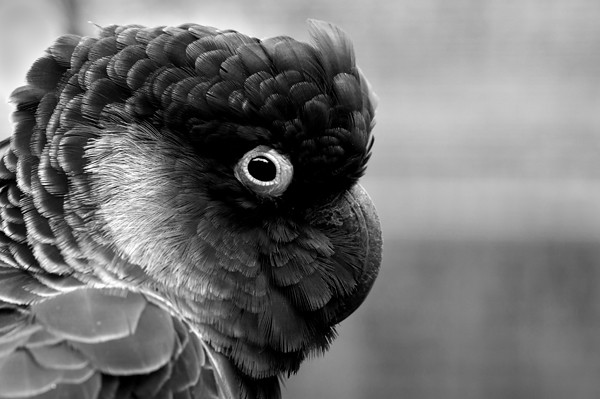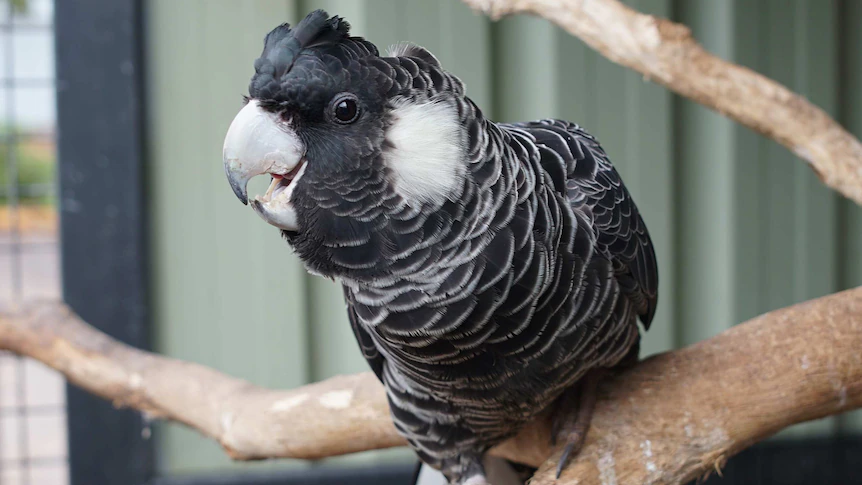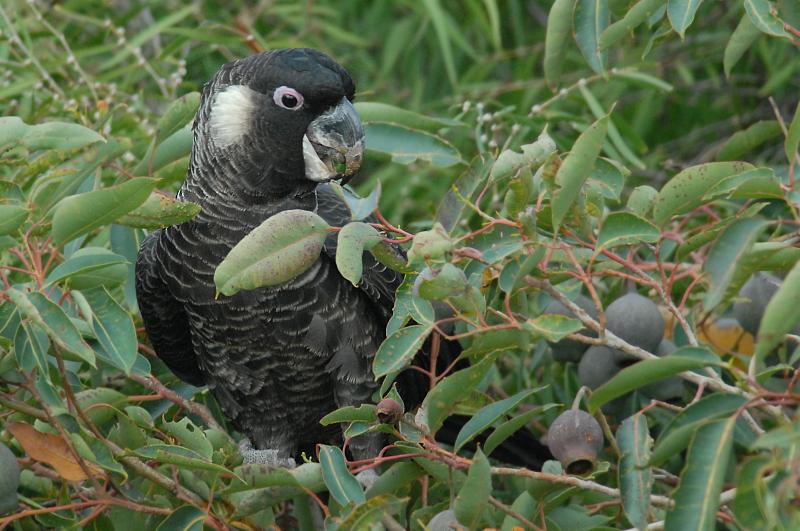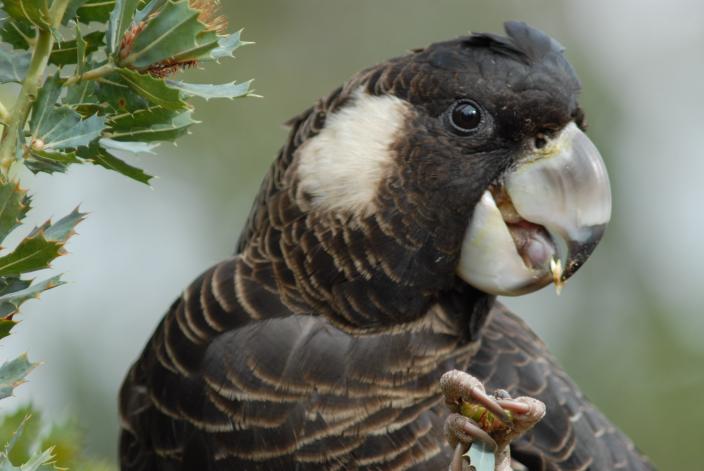Discover the enchanting world of the white tailed black cockatoo in this in-depth exploration. from its distinctive features to the challenges.
Introduction
The world of avian marvels unfolds with the captivating presence of the white tailed black cockatoo, a distinguished species that graces the skies of southwest Australia. This chapter unravels the elegance and mystique surrounding these magnificent birds.
Unveiling the Elegance of the White Tailed Black Cockatoo
The white tailed black cockatoo, scientifically known as Calyptorhynchus latirostris, stands as a testament to nature’s artistry. Inhabiting the picturesque landscapes of southwest Australia, these birds command attention with their unique characteristics. With a wingspan that hints at their grandeur, these cockatoos bear a short crest atop their heads, adding to their regal demeanor.
Introducing this avian wonder involves delving into its habitat, where the diverse ecosystems of southwest Australia provide a fitting backdrop. From the towering trees to the open landscapes, the white-tailed black cockatoo’s presence is intertwined with the region’s natural tapestry.

Significance of the White Tailed Black Cockatoo
Beyond their aesthetic allure, these birds hold ecological importance that extends to the balance of the local ecosystem. Their foraging habits, nesting behaviors, and interactions with other species contribute to the intricate web of life in southwest Australia. Additionally, exploring any cultural significance attached to these majestic creatures unveils the deep-rooted connections between the white tailed black cockatoo and the communities that share its habitat.
As we embark on this exploration, the chapters ahead will dive into the taxonomy, behavior, conservation status, and other facets that make the white tailed black cockatoo a subject of fascination and a symbol of the biodiversity-rich landscapes it calls home.
Taxonomy and Naming
In the intricate tapestry of avian evolution, the white tailed black cockatoo stands as a captivating chapter, weaving its story through taxonomy and nomenclature. This exploration delves into the evolutionary journey and the mysteries held within the names assigned to these majestic creatures.
The Evolutionary Journey: Taxonomy of White Tailed Black Cockatoo
Embarking on the evolutionary odyssey of white tailed black cockatoo unravels a narrative of adaptation and survival. As members of the Calyptorhynchus genus, these birds have etched their place in the family Cacatuid, showcasing their kinship with other notable cockatoo species. The taxonomy extends further to the order Psittaciformes, emphasizing the broader avian context in which these birds thrive.
Historically, the nomenclature of white tailed black cockatoo underwent a fascinating transformation. Referred to as short-billed and long-billed black cockatoos in scientific discourse, the species emerged with distinctive identities—Carnaby’s and Boudin’s. This shift in nomenclature encapsulates not just a change in labels but a recognition of the unique attributes that define each species.
Unraveling the Mystery: Description of White Tailed Black Cockatoo
The allure of the white-tailed black cockatoo lies not only in its name but in the intricate details of its physicality. Unraveling this avian mystery involves a meticulous examination of their characteristics. With a predominantly grey-black hue, adorned with narrow off-white fringes that create a scaly appearance, these cockatoos are a visual spectacle. A patch of cream-colored feathers further distinguishes them, offering a striking contrast.
The evolution of their physical traits is a testament to the adaptive journey these birds have undertaken. From the size and shape of their bills to the nuances of their plumage, each feature serves a purpose in their survival in the diverse ecosystems of southwest Australia.
As we navigate through the taxonomy and description of the white-tailed black cockatoo, the subsequent chapters will unfold additional layers of their existence, including their behavior, habitat preferences, and the conservation challenges they confront.

Behavior and Habitat
Diving into the dynamic realm of the white tailed black cockatoo, this chapter unveils the intricacies of their behavior and the environments they call home. Beyond the feathers and names lies a captivating narrative of survival strategies and ecological niches.
A Glimpse into the Life of Carnaby’s and Boudin’s
As we observe Carnaby’s and Badin’s white tailed black cockatoo in their natural habitat, a tapestry of unique behaviors unfolds. These avian wonders exhibit social patterns, including flock formations and intricate communication through calls and displays. Delve into their feeding habits, exploring how these birds navigate the landscape to secure sustenance.
Their interaction with one another and with the broader ecosystem provides valuable insights into the delicate balance of nature. From courtship rituals to parenting dynamics, each facet of their behavior contributes to the tapestry of biodiversity in southwest Australia.
Understanding the behavioral nuances of these cockatoos also involves exploring how environmental factors influence their daily lives. Whether it’s the search for suitable nesting sites or the impact of climate on their migratory patterns, these aspects weave together to shape the life story of the white tailed black cockatoo.
Conservation Status and Challenges
Beyond the enchanting behaviors lies a stark reality—the conservation status of the white tailed black cockatoo hangs in the balance. Uncover the current state of their existence, with a focus on the challenges posed by human activities and habitat changes. From urbanization encroaching on their territories to the potential threats posed by climate change, the obstacles they face are multifaceted.
In examining the conservation challenges, we must also spotlight the ongoing efforts to protect these majestic birds. Conservation initiatives, research projects, and community engagement play pivotal roles in securing a future where white-tailed black cockatoos thrive. It’s a delicate dance between understanding their behavior and crafting effective strategies for their preservation.
As we navigate through the behavior and conservation landscapes, the subsequent chapters will shed light on different dimensions of the white-tailed black cockatoo’s existence.
Captivating Sounds and Visuals
Embark on a sensory journey into the enchanting world of the white tailed black cockatoo as we unravel the symphony of their skies and the visual marvel they present. This chapter explores the distinctive sounds that echo through their habitats and the visual spectacle created by their plumage, crest, and unique displays.
Symphony of the Skies: Sounds of White Tailed Black Cockatoos
The auditory tapestry of the white tailed black cockatoo is as captivating as their physical presence. Explore the unique vocalizations that resonate through the Australian landscapes. From melodic calls to rhythmic beats, each sound carries significance in their intricate communication system.
Delve into the potential meanings behind their calls, deciphering the language of the skies. Uncover the role of vocal communication in their social structure, including mating rituals, warnings, and the coordination of their impressive flock formations. The symphony of these skies reveals a complex and harmonious avian society.
Visual Marvel: The Appearance of White-Tailed Black Cockatoos
Shift your focus to the visual allure of these majestic birds. Their plumage, characterized by the interplay of dark hues and vibrant accents, is a testament to the aesthetic wonders of nature. Dive into the details of their crest, a distinctive feature that adds to their regal appearance.
As we explore their visual marvel, discover the significance of their markings in the context of courtship rituals and territorial displays. From the sleek lines of white tailed black cockatoo to the ornate patterns of Carnaby’s, each species showcases a unique palette that contributes to the overall visual spectacle.
Witness the elegance of their mating rituals, where the visual display becomes a dance of colors and forms. Understanding the visual aspects of white tailed black cockatoo provides a deeper appreciation for their role in the ecological tapestry.
This chapter unravels the auditory and visual poetry of the white tailed black cockatoo, offering a profound insight into the sensory dimensions of these remarkable creatures.

Human Interaction and Conservation Efforts
In the intricate dance between nature and humanity, the white-tailed black cockatoo stands as a testament to the impact of human activities on fragile ecosystems. This chapter delves into the historical and current repercussions of human interaction with these majestic birds, exploring the conservation efforts in place to safeguard their existence.
Human Impact on White Tailed Black Cockatoos
The annals of history unveil the profound influence of human activities on the white tailed black cockatoos. From habitat encroachment to resource exploitation, the delicate balance of their ecosystems has been disrupted. Dive into the nuanced exploration of the historical footprint, shedding light on the consequences of deforestation, urbanization, and agriculture.
Examine the implications of the pet trade on these birds, unraveling the complexities surrounding illegal trafficking and the challenges posed by captivity. Understand the intersection of cultural practices and their impact, fostering an awareness of the delicate coexistence required for the preservation of this avian species.
Success Stories and Ongoing Initiatives
Amid the challenges posed by human interaction, stories of resilience and conservation emerge. This section showcases successful conservation endeavors that have contributed to the revival of white-tailed black cockatoo populations. Explore the collaborative efforts of environmental organizations, researchers, and local communities in fostering a harmonious relationship between humans and these avian wonders.
Highlight ongoing initiatives that serve as beacons of hope for the future. From habitat restoration projects to community-based conservation programs, witness the dedication of individuals and organizations in ensuring the longevity of the white tailed black cockatoo.
This chapter invites reflection on the delicate balance between human progress and environmental conservation. As we navigate the intricate web of interactions, a call to action emerges, urging us to become stewards of the natural world and advocates for the majestic white-tailed black cockatoos.
Frequently Asked Questions (FAQs)
In the realm of curiosity surrounding the white-tailed black cockatoo, let’s unravel the enigma through a series of frequently asked questions.
Is there a white tailed black cockatoo?
Yes, indeed. The white tailed black cockatoo, scientifically known as Calyptorhynchus latirostris, graces the landscapes of southwest Australia. Distinguished by its elegance and unique features, this avian marvel captivates both seasoned bird enthusiasts and casual observers.
What are the 5 black cockatoos in Australia?
Australia boasts a diverse array of black cockatoos. The five notable species include the iconic white-tailed black cockatoo (Calyptorhynchus latirostris), Carnaby’s cockatoo (Calyptorhynchus latirostris), Boudin’s cockatoo (Calyptorhynchus bauhinia), the red-tailed black cockatoo (Calyptorhynchus banksia), and the yellow-tailed black cockatoo (Calyptorhynchus funerals). Each species possesses its own distinctive characteristics, contributing to the rich avian tapestry of the continent.
Is it rare to see black cockatoos?
The visibility of black cockatoos, including the white-tailed variety, is subject to various factors. While these majestic birds are not uncommon in their native habitats, their presence may be influenced by seasonal patterns, habitat changes, and human activities. Witnessing these birds in their natural environment is a captivating experience, and efforts to protect their habitats contribute to ensuring their continued visibility.
Navigate the realms of curiosity, armed with these succinct answers that shed light on the mysteries surrounding the white-tailed black cockatoo.
Conclusion
As we draw the curtain on this exploration of the enchanting white-tailed black cockatoo, it’s time to reflect on the majesty and significance of these avian wonders.
Embracing the Majesty of White-Tailed Black Cockatoos
In the vast tapestry of Australia’s wildlife, the white tailed black cockatoo emerges as a symbol of elegance and ecological importance. From its distinctive appearance to the symphony of sounds it contributes to the skies, this species stands as a testament to the richness of biodiversity in southwest Australia.
Key Insights:
- Biodiversity Guardians: The white tailed black cockatoo, scientifically known as Calyptorhynchus latirostris, plays a pivotal role in the delicate balance of the local ecosystem. Its foraging habits and interactions with other species contribute to the region’s biodiversity.
- Cultural Threads: Beyond its ecological significance, these cockatoos weave cultural threads in the fabric of southwest Australia. Indigenous communities often hold profound beliefs and cultural significance attached to the presence of these majestic birds, adding a layer of cultural richness to their existence.
- Conservation Imperative: Despite their significance, white tailed black cockatoo face challenges, prominently habitat loss and potential threats. As stewards of the environment, it becomes imperative for us to recognize and address these challenges. Conservation efforts are not just about preserving a species; they are a commitment to the overall health of the ecosystem.
Advocating for Conservation:
In advocating for the conservation of white tailed black cockatoo, we echo the importance of preserving not just a species but the intricate web of life it sustains. Success stories and ongoing initiatives underscore the positive impact that collective efforts can have on the well-being of these birds.
Let us carry forward the appreciation cultivated through this journey, recognizing the majesty of the white-tailed black cockatoo and championing the cause of conservation. The skies, the trees, and the cultural narratives of southwest Australia are undoubtedly richer with the presence of these remarkable creatures.

1 thought on “White Tailed Black Cockatoo: Elegance in Monochrome”
Comments are closed.